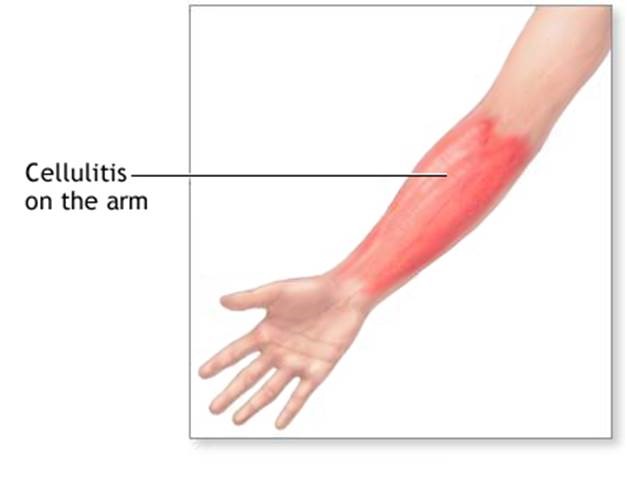Erysipelatous inflammation
Erysipelatous inflammation is a common skin infection caused by bacteria.
Causes
Staphylococcus and streptococcus bacteria are the most common causes of erysipelatous inflammation.
Normal skin has many types of bacteria living on it. When there is a break in the skin, these bacteria can cause a skin infection. Skin in the infected area will become red, hot, irritated, swollen, and painful.

Erysipelatous inflammation is a noncontagious inflammation of the connective tissue of the skin, resulting from a bacterial infection. Antibiotics are given to control infection, and analgesics may be needed to control pain. Within 7 to 10 days of treatment erysipelatous inflammation can be cured.
Risk factors for erysipelatous inflammation include:
- Cracks or peeling skin between the toes
- History of peripheral vascular disease
- Injury or trauma with a break in the skin (skin wounds)
- Insect bites and stings, animal bites, or human bites
- Ulcers from certain diseases, including diabetes and vascular disease
- Use of corticosteroid medications or medications that suppress the immune system
- Wound from a recent surgery
Symptoms
Symptoms of erysipelatous inflammation include:
- Fever
- Pain or tenderness in the affected area
- Skin redness or inflammation that gets bigger as the infection spreads
- Skin sore or rash that starts suddenly, and grows quickly in the first 24 hours
- Tight, glossy, stretched appearance of the skin
- Warm skin in the area of redness
Signs of infection:
- Chills or shaking
- Fatigue
- General ill feeling
- Muscle aches and pains
- Warm skin
- Sweating
Other symptoms that can occur with this disease:
- Hair loss at the site of infection
- Joint stiffness caused by swelling of the tissue over the joint
- Nausea and vomiting
Exams and Tests
The health care provider will perform a physical exam. This may reveal:
- Redness, warmth, and swelling of the skin
- Possible drainage, if there is an infection
- Swollen glands (lymph nodes) near the affected area
Your health care provider may mark the edges of the redness with a pen, to see if the redness goes past the marked border over the next several days.
Tests that may be ordered include:
- Blood culture
- Complete blood count (CBC)
- Culture of any fluid or material inside the affected area
Treatment
You will likely be prescribed antibiotics to be taken by mouth. You may be given pain medicine as well.
At home, raise the infected area higher than your heart to reduce swelling. Rest until your symptoms improve.
You may need to stay in a hospital if:
- You are very sick (for example, you have a very high temperature, blood pressure problems, or nausea and vomiting that does not go away)
- You have been on antibiotics and the infection is getting worse
- Your immune system is not working well (due to cancer, HIV)
- You have an infection around your eyes
- You require antibiotics through a vein (IV)
Outlook (Prognosis)
Erysipelatous inflammation usually goes away after taking antibiotics for 7 to 10 days. Longer treatment may be needed if erysipelatous inflammation is more severe. This may occur if you have a chronic diseases or your immune system is not working properly.
People with fungal infections of the feet may have erysipelatous inflammation that keeps coming back. Cracks in the skin from the fungal infection allows the bacteria to get into the skin.
Possible Complications
- Blood infection (sepsis)
- Bone infection (osteomyelitis)
- Inflammation of the lymph vessels (lymphangitis)
- Inflammation of the heart (endocarditis)
- Meningitis
- Shock
- Tissue death (gangrene)
When to Contact a Medical Professional
Call your health care provider if:
- You have symptoms of erysipelatous inflammation
- You are being treated for erysipelatous inflammation and you develop new symptoms, such as persistent fever, drowsiness, lethargy, blistering over the erysipelatous inflammation, or red streaks that spread
Seek medical attention right away if the erysipelatous inflammation is on your face.
Prevention
Protect your skin by:
- Keeping your skin moist with lotions or ointments to prevent cracking
- Wearing shoes that fit well and provide enough room for your feet
- Learning how to trim your nails to avoid harming the skin around them
- Wearing appropriate protective equipment when participating in work or sports
Whenever you have a break in the skin:
- Clean the break carefully with soap and water. Apply an antibiotic cream or ointment every day.
- Cover with a bandage and change it every day until a scab forms.
- Watch for redness, pain, drainage, or other signs of infection.
Source: http://www.nlm.nih.gov/medlineplus/ency/article/000855.htm

